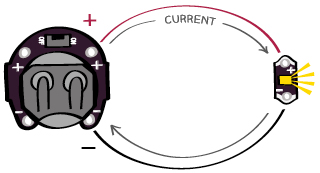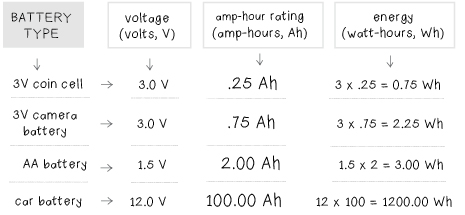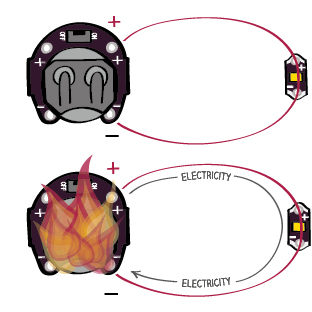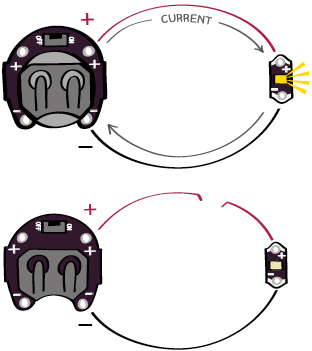UNDERSTANDING YOUR CIRCUIT
Now that you’ve built a circuit, it’s time to explore how it works.
Generally, a circuit consists of a power source like a battery that is connected through a conductive material—a material that electricity flows through easily—to other electronics like lights, motors, switches, or sensors. In the circuit you built, you used a coin cell battery, an LED light, and a soft conductive thread to make the connections.
CURRENT, VOLTAGE, AND ENERGY
The LED in your circuit turns on when electricity flows through it. This flow is called an electric current. Electric current is measured in amps. In your circuit, current flows from the (+) side of the battery through conductive thread, then through the LED, then more conductive thread and finally back to the (–) side of the battery.

All batteries have two important ratings. They have a voltage rating and an amp-hour rating. The voltage rating tells you how many volts your battery can supply and the amp-hour rating tells you how much current it can supply for how long. Together, these two ratings tell you how much energy is stored in the battery.
The coin cell battery that you’re using for this project is a 3-volt battery with an amp-hour rating of .25 amp-hours. This
means that the battery can supply .25 amps of current at 3 volts for 1 hour before it dies. The circuit you built uses about .025 amps of current when it’s turned on (1/10th of .25 amps). This means that your battery should last about 10 hours. If you used a bigger battery with a higher amp-hour rating—like a camera battery with a .75 amp-hour rating—it would last longer. Here’s a table showing how the two compare:

If you multiply the amp-hour rating by the voltage rating you get a measure of the total amount of energy stored in a battery. Energy is measured in watt-hours. The coin cell battery stores .75 watt-hours of energy (3 volts * .25 amp hours) and the camera battery stores 2.25 watt-hours of energy. In comparison, a typical car battery has a rating of 50-100 amp-hours and 12 volts. It can store 1200 watt hours of energy—1600 times more than your coin cell!
ENERGY RATINGS FOR DIFFERENT BATTERIES
The voltage rating of a battery tells you the difference in voltage from its (+) and (-) sides. The (-) side of any battery is always at 0 volts. When a battery is fully charged, the (+) side should be at its rated voltage. So, the (+) side of a charged coin cell battery should be at 3 volts, the (+) side of a car battery should be at 12 volts and the (+) side of a AA battery should be at 1.5 volts.

VOLTAGE: SYMBOLS, VALUES, AND NAMES FOR A 3V BATTERY
In electronics convention, the (+) side of a battery is called power or HIGH. The (–) side is called ground or LOW. Red is the color used to indicate power and black is the color used to indicate ground in electrical diagrams.

SHORT CIRCUITS
What would happen if you connected the (+) and (–) sides of your battery directly? That is, what if you sewed conductive thread right across the LED’s (+) and (–) tabs.
Well, imagine connecting the (+) and (–) sides of a car battery together. Or, even worse, connecting the two slots in an electrical outlet on your wall. When the (+) and (–) sides of a power source like a battery or an electrical outlet are directly connected to each other with a conductive material—like a jumper cable, a bobby pin, or a piece of conductive thread—this is called a short circuit or simply a short. When a short circuit occurs, the circuit’s power supply releases a tremendous burst of energy. When this happens, most of the energy that is stored in the battery is released all at once. If you “short circuit” your coin cell battery, the
entire .75 watt-hours will be released in an instant.

This burst can be very dangerous and destructive. It is likely to ruin your battery, since it drains all of the battery’s energy very quickly, and can electrocute or burn you if the power supply is powerful enough (like a car battery or a wall outlet).
Fortunately, the batteries you’re using for the projects in this book won’t shock or burn you, even if you create a short circuit. But, if you do create one—by directly connectting your battery’s (+) and (–) sides—your project will not work and you’ll quickly ruin your battery.
Short circuits are easy to create in fabric circuits. A loose thread, unraveling knot, messy stitch, or folded piece of fabric can cause your battery’s (+) and (–) to touch each other.
It’s important to think about and check for short circuits as you design, sew, and troubleshoot your projects. Examples of problems that may cause short circuits are shown below. From left to right: a loose thread brushes against a circuit board, two traces cross, long knot tails come into contact.

SWITCHES
Electric current only flows through a circuit when there is a complete path leading from (+) on the battery through the circuit and back to (–) on the battery; from power to ground. If there is a break in this path, the electricity stops moving. If you patch the break in the path with a conductive material, the electricity is able to flow again.
This is how switches work. A switch opens up a break in a circuit and then closes it. When you flip a light switch on your wall this is what it’s doing. This is also what is happening when you flip the switch on your battery holder.
